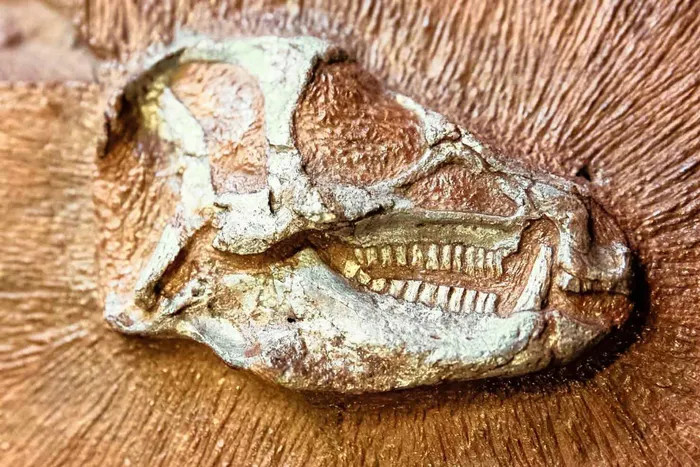Karoo fossil globe-trots for forensic analysis

The skull of the Heterodontosaurus tucki dinosaur. Picture: Pierre Jayet The skull of the Heterodontosaurus tucki dinosaur. Picture: Pierre Jayet
The skeleton of a dinosaur which roamed the Eastern Cape about 200 million years ago had to be flown across the globe in order for intimate details about its origins to be revealed.
The Heterodontosaurus tucki skeleton was taken to Grenoble in France to undergo high-energy X-rays in order to find out more about how it ate, moved and breathed.
A group of scientists from the Evolutionary Studies Institute at Wits University who joined experts at the European Synchrotron Radiation Facility (ESRF) spent the past five days scanning and examining the skeleton of the small dinosaur.
The specimen, which was discovered by South African palaeontologist Billy de Klerk in a stream bed on a farm near Grahamstown in 2005, is the most complete fossil of H.tucki ever discovered.
The heterodontosaurus was a small, plant-eating animal with grinding teeth in the back of the jaw and big canines in the front.
Wits Professor Jonah Choi-niere, who led the team, described the images obtained during their visit as amazing.
“Right away when we open these images, we can tell quite a few things about the skull. One of the things is that it’s likely a juvenile,” he said.
“We can see the openings in the skull, which are for the balance organs. We can digitally reconstruct the balance organs of the animal and tell how it held its head and how it interacted with its environment.
“That’s the sort of data you just can’t get by looking at a skull in 2D. It’s very exciting.”
He said there was still a lot that scientists didn’t know about plant-eating dinosaurs.
“We need new specimens like this one and new techno-logy like the synchrotron to fill in the gaps.”
This work is part of a long- standing collaboration between palaeo scientists based at the ESRF and in South Africa.
Last year, the ESRF’s Dr Vincent Fernandez arranged for some of the world’s oldest dinosaur embryos, originating from South Africa, to be scanned at the facility.
“The rocks of the Karoo have yielded an extraordinary amount of amazing fossils,” Fernandez said.
“Since South Africa has joined as a member country, we were able to scan a lot of these fossils and work on projects that were not accessible before”.
After De Klerk discovered the fossil, he, along with John Hepple - a technician from Rhodes University’s geology department - and a crew from Grahamstown’s Albany Museum, excavated the fossil.
They painstakingly re-moved enough rock from the bones to identify the specimen.
“A few more years on the stream bed and the specimen might have been washed away. We just happened to be at the right place at the right time,” De Klerk said.
But because the skeleton was so small and delicate and the rocks around it so hard, scientists were unable to do any other preparation work which would enable them to study the anatomy of the fossil further.
On top of this, the fossilised bone and the rocks surrounding it have a similar density.
The synchrotron however, which generated high-energy X-rays - 100 billion times brighter than those used in hospitals - allowed the scientists to reconstruct the skeleton in detail.
The high coherence of the beam enhanced the contrast in the images, allowing the scientists to “dig out” the fossil from the rocks.
Wits master’s student Kathleen Dollman was part of the team that went to France. She said the technique has revolutionised the study of fossils.
@Gabi_Falanga